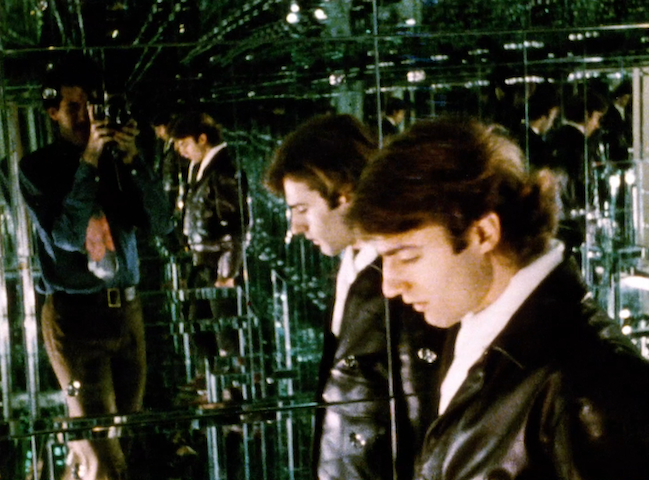GME STREAMLINE PRESENTS TWO ADDITIONAL WARREN SONBERT FILMS FROM THE 1960’S AS DOWNLOADABLE DSL FILES
/For the first time ever, GME Streamline is pleased to announce the release in digital format of 2 Warren Sonbert films from 1967, THE TENTH LEGION and THE BAD AND THE BEAUTIFUL. This complements our previous release of Sonbert’s first three films, all from 1966: AMPHETAMINE, WHERE DID OUR LOVE GO?, and HALL OF MIRRORS. All five titles are now available via Digital Site Licenses as downloadable digital files. These films encompass Sonbert’s extant sound films from the 1960’s – the era of sex, drugs, and rock and roll. All of these early films of Warren Sonbert are now available for acquisition as DSL files for the North American university community, as well as for international exhibition.
We previously made available a selection of Sonbert’s first films as free through GME Streamline. This turned out to be a very popular presentation and has led us now to offer THE BAD AND THE BEAUTIFUL as a free stream for a limited time on GME’s Streamline site.
Warren Sonbert was one of the seminal figures working in American experimental film. He started making films in 1966 while a student at New York University, and before he was 20 years old, his first career retrospective drew the attention of the film critic for the commercial trade journal Variety, who wrote that “Probably not since Andy Warhol’s The Chelsea Girls had its first showing at the Cinematheque... almost a year and a half ago has an ‘underground’ film event caused as much curiosity and interest in N.Y.’s non-underground world as did four days of showings of the complete films of Warren Sonbert at the Cinematheque’s new location on Wooster St.”
Sonbert’s earliest films, in which he captured the spirit of his generation, were inspired first by the university milieu and then by the denizens of the Warhol art scene, including superstars Rene Ricard and Gerard Malanga. In these loosely structured narratives, Sonbert boldly experimented with the relationship between filmmaker and protagonists through extensively choreographed hand-held camera movements within each shot. The mood of these films was further modulated by chiaroscuro effects, achieved primarily through natural lighting (in both indoor and outdoor shots), combined with variations in the raw film stock and the exposure and the use of rock-and-roll music on the soundtrack.
One of the most profound themes coursing through Sonbert’s work is that of love between couples in all its pitfalls and perfect moments. To express this theme, Sonbert employed diverse cinematic strategies. These include in-camera editing (in THE BAD AND THE BEAUTIFUL,1967), twin-screen effects (in two “lost” films -- CONNECTION and TED AND JESSICA -- also both from 1967), and montage sequences (beginning with TUXEDO THEATRE, 1969).
THE BAD AND THE BEAUTIFUL can be seen as Sonbert’s foremost experiment in negotiating the space between his hand-held camera and the protagonists in his field of vision. Editing in camera, Sonbert then assembled together the 100’ camera rolls into a series of mini-narratives.
Through elaborately choreographed camera movements, Sonbert dynamically captures each individual couple in unusually intimate, quotidian moments: reading and eating, playing music and dancing, cavorting and lovemaking, and whiling away the time.
Sonbert carefully chose the titles for his films, and no clearer reference to Hollywood is evident than with THE BAD AND THE BEAUTIFUL, Sonbert’s own take on Vincent Minnelli’s 1952 movie of the same name. As if to further underscore his homage, Sonbert’s main title and credit sequences flashes on the screen in a manner similar to the opening of Minnelli’s film.
The MGM trailer for Minnelli’s THE BAD AND THE BEAUTIFUL promotes a view of “the private lives of the famous and notorious.” Sonbert’s film, featuring Warhol’s superstar René Ricard and other beautiful people, takes place within the private world of New York City apartment buildings. In Minnelli’s movie, Jonathan Shields,the character played by Hollywood star Kirk Douglas, acts as an omnipotent Hollywood producer promising to fulfill the destiny of his fellow protagonists – a director, a screenwriter, and an actress. In Sonbert’s film, critic James Stoller observed that most of the couples had the feeling that “appearing in a Sonbert film was part of their manifest destiny and that something must have been lacking in their lives together until he came along to complete or sanctify their unions.”
◊
In THE TENTH LEGION, Sonbert presents his college age friends at work and play, wandering the streets of NYC, lounging, shopping, and posing for the camera. The film stylistically exemplifies Sonbert’s masterful use of a constantly moving hand-held camera as it trails the teenage protagonists in choreographed fashion, and of chiaroscuro lighting effects in interior scenes.
Sonbert was not only a noteworthy avant-garde filmmaker, but also a noted film critic, writing regularly for publications in the San Francisco Bay Area. His articles about commercial Hollywood films are among his most extraordinary, profound, and insightful creations. Sonbert was fascinated by the manner in which Hollywood directors “exposed and undermined the hollow cupidity and superficiality of idle-class ideals of the Eisenhower years in America.” Sonbert’s THE TENTH LEGION and Nicholas Ray’s REBEL WITHOUT A CAUSE (1955) portray the idle wandering of middle-class youths; both films convey a sense of beautiful people lost on the cusp of adulthood.
As film critic James Stoller once wrote about THE TENTH LEGION, “I think part of [Sonbert’s] sensibility is related to a set of New York City hip values of appearance and lack of productivity. In other words, this is the age in Sonbert’s life, in his characters’ lives, that they are to live stylishly and not contently.” In titling his film THE TENTH LEGION, Sonbert invariably refers to an elite army formed by Julius Caesar, which subdued the Jewish rebellion at Masada, just as the youth in Sonbert’s film have the burgeoning ambition of taking over the world-at-large (especially as they are seen working for such colorful art world figures as Henry Geldzhaler and Fred Hughes). Sonbert’s film ends with his young protagonists entering and exiting a movie theater with Frank Sinatra’s nostalgic song about passing youth, “Young at Heart,” playing on the soundtrack; for Ray, the film results in the tragic death of Sal Mineo’s character, a wake-up call to adulthood.
◊
As a reminder about GME's initial foray into the distribution of approximately 100 digital site licenses (DSL) available for films in our catalog, whether as DVD/DSL bundles or directly downloadable HD DSL files from our server, we present the following selection of initial GME Streamline offerings. Many more titles will soon become available from GME Streamline in both formats, in addition to new titles reflecting our recent partnership with Kino Lorber, new artists to be announced this fall, and additional resources from various, international boutique publishers. Please feel free to contact us at anytime to inquire about DSL and/or DVD and Blu-ray disk releases available from our online catalog, or regarding titles that don't yet appear on our website.
All photographs and films are © The Estate of Warren Sonbert






